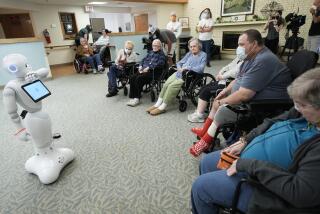Robot ‘Nurses’ May Soon Find Their Way Onto Hospitals’ Staffs
- Share via
STANFORD, Calif. — Mechanical devices now used to assistrehabilitation of hospital patients are only the front lines of a platoon of robots that could soon march into the medical care field, scientists say.
Robots may shortly be able to help flex stiff joints of patients in physical therapy, bathe elderly people in nursing homes, assist surgeons in operating rooms and process blood or urine samples in medical laboratories.
In Japan, scientists have already built and clinically tested a two-armed robot manipulator that can transfer patients between gurney and bed. Some hospitals in the United States have experimental mobile robot carts that follow preset paths to deliver meals and linen.
“Robots have a potentially rich and complex future in medicine,” said Larry Leifer, a Stanford University professor of mechanical engineering who envisions robots rolling down hospital corridors.
Can Free Professionals
Leifer said robots, which can work around-the-clock, can free nurses and other health professionals for more skilled medical tasks.
At the Palo Alto Veterans Administration Medical Center, Leifer heads a Rehabilitation Research and Development team of medical and engineering experts who are developing robotic devices to help the disabled.
The major product of the team has been development of a microcomputer-directed mechanical arm that manipulates objects in response to the voice commands and small physical movements of its operator.
The two-fingered robotic arm can respond to 58 verbal commands. It has a special “joy stick” to control its movement and can be pre-programmed to carry out a planned sequence of motions.
Not a Prosthetic Device
Although the robotic arm is seen a tool for replacing a lost function, it is not a prosthetic device designed to replace anatomy, Leifer said.
However, he said, its dexterity could help loosen the shackles of paralysis for an estimated 40,000 quadriplegics in the United States and assist 200,000 others who have severe physical limitations.
In the future, Leifer said, he sees robot physical therapists helping patients build back strength and dexterity. In surgery, they could assist in applying clamps, fetching materials or holding and passing instruments. Robots could also do such routine chores as rearranging pillows, replacing bedpans, checking sensors and helping patients roll over in bed.
Current versions of the robotic arm are limited in mobility because they are bolted to a table. Their ability to define objects using optical sensors in a simple two-fingered hand also needs improvement.
‘Whisker’ Sensors
Leifer said that a future model may incorporate “whisker” sensors that could lightly brush surfaces of objects, enabling the robotic hand to scan contours in a nearly tactile fashion.
The new machine will also be designed as a wheel-like contraption enabling it to move through doorways as it is steered remotely by ultrasonic sensors on the backs of wheelchairs.
Patients requiring 24-hour attendance could gain partial independence through the use of robotic aids, Leifer said.
“Disabled individuals live at a level of intimacy with a caretaker that most people very rarely choose on their own. They swallow their pride and do it--they have to--but they would prefer to take care of themselves.”
Cut Reduce Costs
Robots used at an estimated $6 an hour could also reduce the cost of attendant care, which runs about $15 an hour, Leifer said.
Dr. Paul Haber, who directs programs for the elderly at the Veterans Administration Hospital, said he is a strong advocate of robot technology to help older patients.
“We don’t want to depersonalize nursing homes, but many nursing tasks are boring, difficult, unpleasant and demeaning for both patient and caretaker.”
Robots, he said, could do things such as bathing, feeding, transferring and grooming patients.
“And a robot isn’t going to come in hung over or grumpy and abusive,” Haber said.






